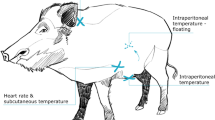Abstract
The European red squirrel Sciurus vulgaris inhabits areas which undergo profound seasonal declines in food availability and ambient temperature. We measured the body temperature (Tb) of free-ranging S. vulgaris over the course of one year to examine its thermoregulatory strategies and found no evidence of heterothermy, with Tb never dropping below 36.7 °C. A lower average Tb and a reduced active phase are likely to have resulted in some energetic savings, sufficient for survival during the particularly mild winter with unhindered access to food stores. We cannot exclude that a different Tb pattern may be seen in energetically more demanding years, but we can confirm that heterothermy is not an obligatory behaviour in this species to counter energetic bottlenecks. Either S. vulgaris is indeed a strict homeotherm, or the need for torpor is flexibly adjusted.
Similar content being viewed by others
References
Bakko, E.B., Porter, W.P., Wunder, BA, 1988. Body temperature patterns in black tailed prairie dogs inthe field, Can. J. Zool. 66, 1783–1789.
Brigham, R.M., Geiser, F., 2012. Do red squirrels (Tamiasciurus hudsonicus) use daily torpor during winter? Ecoscience 19, 127–132.
Cade, T.J., 1964. The evolution of torpidity in rodents, Ann. Acad. Sci. Fenn. 76, 78–112.
Fletcher, Q.E., Speakman, J.R., Boutin, S., McAdam, A.G., Woods, S.B., Humphries, M.M., 2012. Seasonal stage differences overwhelm environmental and individual factors as determinants of energy expenditure in free-ranging red squirrels, Funct. Ecol. 26, 677–687.
Geiser, F., Holloway, J.C, Körtner, G., 2007. Thermal biology, torpor and behaviour in sugar gliders: a laboratory-field comparison, J. Comp. Physiol. B 177, 495–501.
Geiser, F., Holloway, J.C, Körtner, G., Maddocks, T.A., Turbill, C, Brigham, R.M., 2000. Do patterns of torpor differ between free-ranging and captive mammals and birds? In: Heldmaier, G., Klingenspor M (Eds.), Life in the Cold: 11th International Hibernation Symposium. Springer, Berlin, Heidelberg and New York, pp. 95–102.
Glanville, E.J., Murray, S.A., Seebacher, F., 2011. Thermal adaptation in endotherms: climate and phylogeny interact to determine population-level responses in a wild rat, Funct. Ecol. 26, 390–398.
Golightly Jr., R.T., Ohmart, R.D., 1978. Heterothermy in free-ranging Abert’s squirrels (Sciurus aberti). Ecology 59, 897–909.
Harlow, H.J., 1995. Fasting biochemistry of representative spontaneous and facultative hibernators: the white-tailed prairie dog and the black-tailed prairie dog, Physiol. Zool. 68, 915–934.
Heldmaier, G., Neuweiler, G., 2004. Vergleichende Tierphysiologie, vol. 2. Springer, Berlin, Heidelberg and New York, pp. 60–68.
Humphries, M.M., Boutin, S., Thomas, D.W., Ryan, J.D., Selman, C, McAdam, A.G., Berteaux, D., Speakman, J.R., 2005. Expenditure freeze: the metabolic response of small mammals to cold environments, Ecol. Lett. 8, 1326–1333.
Kobbe, S., Dausmann, K.H., 2009. Hibernation in Malagasy mouse lemurs as a strategy to counter environmental challenge, Naturwissenschaften 96, 1221–1227.
Kobbe, S., Ganzhorn, J.U., Dausmann, K.H., 2011. Extreme individual flexibility of heterothermy in free-ranging Malagasy mouse lemurs (Microcebus murinus). J. Comp, Physiol. B 181, 165–173.
Larivée, M.L., Boutin, S., Speakman, J.R., McAdam, A.G., Humphries, M.M., 2010. Associations between over-winter survival and resting metabolic rate in juvenile North American red squirrels, Funct. Ecol. 24, 597–607.
McNab, B.K., 1970. Body weight and the energetics oftemperature regulation, J. Exp. Biol. 53, 329–348.
Nowack, J., Mzilikazi, K., Dausmann, K. H., 2010. Torpor on demand: heterothermy in non-lemur primates Galago moholi. PLoS ONE 5 (5), e10797.
Pauls, R.W., 1978. Body temperature dynamics of the red squirrel (Tamiasciurus hudsonicus): adaptations for energy conservation, Can. J. Zool. 57, 1349–1354.
Pereira, M.E., Aines, J., Scheckter, J.L., 2002. Tactics of heterothermy in eastern gray squirrels (Sciurus carolinensis). J, Mammal. 83, 467–477.
Pretzlaff, I., Kerth, G., Dausmann, K.H., 2010. Communally breeding bats use physiological and behavioural adjustments to optimize daily energy expenditure, Naturwissenschaften 97, 353–363.
Pulliainen, E., 1973. Winter ecology of the red squirrel (Sciurus vulgaris L) in northeastern Lapland, Ann. Zool. Fenn. 10, 487–494.
Refinetti, R., 1999. Relationship between the daily rhythms of locomotor activity and body temperature in eight mammalian species, Am. J. Physiol. 277, R1493–R1500.
Reynolds, J.C., 1985. Autumn-winter energetics of Holarctic tree squirrels: a review, Mammal. Rev. 5, 137–150.
Rodrigues, D., Wauters, LA., Romeo, C, Mari, V., Preatoni, D., Mathias, M-da L., Tosi, G., Martinoli, A., 2010. Living on the edge: can Eurasian red squirrels (Sciurus vulgaris) persist in extreme high-elevation habitats? Arct, Antarct. Alp. Res. 42, 106–112.
Schleucher, E., Hilmer, S., Angus, G.J., Algar, D., Warnecke, L., 2008. The effect of captivity on thermal energetics in native and invasive species: are physiological capacities a key factor in colonisation of new habitats in Australia? In: Rabitsch, W.F., Essl, F., Klingenstein, F. (Eds.), Biological Invasions - From Ecology to Conservation, vol. 7. Neobiota, pp. 165–179.
Schmid, J., Kappeler, P.M., 1998. Fluctuating sexual dimorphism and differential hibernation by sex in a primate, the gray mouse lemur (Microcebus murinus). Behav, Ecol. Sociobiol. 43, 125–132.
Schmid, J., Ganzhorn, J.U., 2009. Optional strategies for reduced metabolism in gray mouse lemurs, Naturwissenschaften 96, 737–741.
Tonkin, J.M., 1983. Activity patterns of the red squirrel (Sciurus vulgaris). Mammal, Rev. 13, 99–111.
Turner, J.M., Warnecke, L., Körtner, G., Geiser, F., 2012. Opportunistic hibernation by a free-ranging marsupial, J. Zool. 286, 277–284.
Warnecke, L., Withers, P.C., Schleucher, E., Maloney, S.K., 2007. Body temperature variation of free-ranging and captive southern brown bandicoots Isoodon obe-sulus (Marsupialia: Peramelidae), J. Therm. Biol. 32, 72–77.
Wauters, LA., Dhondt, A.A., 1987. Activity budget and foraging behaviour of the red squirrel (Sciurus vulgaris, Linnaeus, 1758) in a coniferous habitat, Z. Säugetierkd. 52, 341–352.
Wauters, L., Swinnen, C, Dhondt, A.A., 1992. Activity budget and foraging behaviour of red squirrels (Sciurus vulgaris) in coniferous and deciduous habitats, J. Zool. 227, 71–86.
Witter, M.S., Cuthill, I.C., 1993. The ecological costs of avian fat storage. Philos. Trans. R. Soc. B340, 73–92.
Author information
Authors and Affiliations
Corresponding author
Rights and permissions
About this article
Cite this article
Dausmann, K.H., Wein, J., Turner, J.M. et al. Absence of heterothermy in the European red squirrel (Sciurus vulgaris). Mamm Biol 78, 332–335 (2013). https://doi.org/10.1016/j.mambio.2013.01.004
Received:
Accepted:
Published:
Issue Date:
DOI: https://doi.org/10.1016/j.mambio.2013.01.004




